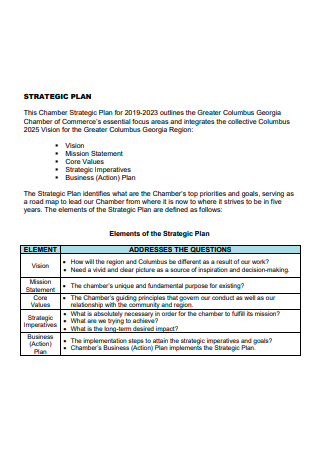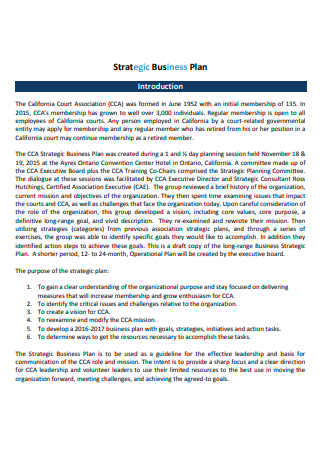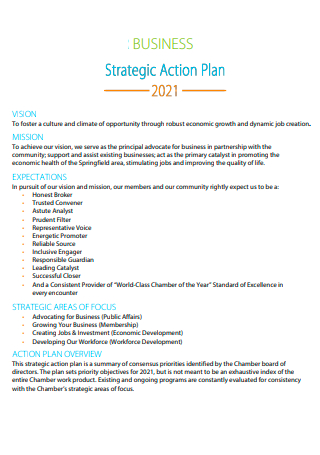3+ Sample Strategic Business Action Plan
FREE Strategic Business Action Plan s to Download
3+ Sample Strategic Business Action Plan
What IS a Strategic Business Action Plan?
Payoffs of a Good Business Action Planning
Making the Strategic Business Action Plan
FAQs
What are the different pricing strategies in marketing?
Why is strategic planning crucial for businesses?
What are the best practices to effectively implement your action plans?
What IS a Strategic Business Action Plan?
A strategic business action Plan is a make-or-break strategy for a business’s success in the market. It is a piece of document that lays out the strategic action plans to be taken to accomplish a business’s goals and objectives. Action plans often adhere to a SMART goal method, meaning that plans should be Specific, Measurable, Achievable, Relevant, and Time-bound. Action plans should be specific, clearly identified. Answering the questions of what, where, who, which and why can make your plans more focused and concrete. Action plans should also be measurable in such a way that you can be able to track and monitor each plans’ progress.
Questions being answered by a measurable action plan include how many and how much. Achievable is also another trait to make an action plan effective. You cannot just create strategic steps that are without foundation, that are baseless. Achievable is akin to realistic. Action plans are created based on market research and if there is a current need in the market. Being relevant is also important. Relevant means that the strategies created are aligned with your business goals, mission, and vision, as well as the current trend or need that exists in the market. You need to ask if the plans are executed at the appropriate time, in the right socio-economic environment, and that the skills being utilized are appropriate to the strategies. Action plans should also be time-bound. Goals and objectives need to have a deadline. A deadline sets the urgent tone for strategies, enabling those who are in charge to focus and work consistently towards meeting the goals and objectives.
Payoffs of a Good Business Action Planning
Whether the goals of a company are set for a short term or a long term period, proper and effective planning should be made. There are many different uses for an action planning document. Those uses can be for financial goals, marketing goals, brand marketing goals, sales goals, operational and production goals, and so on. But what exactly can be gained from creating business action plans?
Making the Strategic Business Action Plan
A strategic business action plan is a roadmap of a business’s success in terms of achieving its goals and objectives. Businesses often fail because they do not do proper planning or strategize in the first place. Having a good and well-prepared action can alter the course of your business’s journey. If prepared properly, with all the right research and analysis, the achievement could go far and beyond the goal that was established in the first place. Technically speaking, there is no strict format when it comes to drafting a strategic business action plan. But to make the planning successful, however, is to ensure the following essential elements are included in the planning process.
-
1. Executive Summary
The executive summary of a strategic business action plan provides a brief background about the business and its products or services. It also lists what are the goals and objectives that the business has for having its action plan. The executive summary technically is an overview of what the whole strategic business action plan contains. It should be written in a clear, concise way, and interesting enough so that the reader or the audience will look forward to finding out more about the whole action plan.
Executive summaries often contain the mission and vision statements. A mission statement states the purpose for the creation of the action plan. It is also a reflection of the business’s culture and values. A vision statement depicts what the business hopes to achieve with the strategic action plan, usually in a provided time frame. The vision statement also sets the tone for the whole plan, motivating and inspiring people who were given tasks and responsibilities within the planning process to all come together, stay focused, and work consistently towards achieving the goals.
-
2. Market Analysis
Creating a market analysis is also important in any strategic planning. A market analysis helps a business understand the kind of market it is going into. It talks about the market condition, the growth, the trends, and even about the existing competitors in the market. The analysis helps prepare the business for what it is going to encounter and the potential impacts it will be experiencing, which is important if you want to strategically position your business in the market. One way of doing a market analysis is to get an understanding of your target market. Studying your target market means grouping them according to their demographics, such as age, gender, income, location, lifestyle, culture, affiliations, et cetera.
SWOT analysis is also another way of preparing your business for the market. SWOT means Strengths, Weaknesses, Opportunities, and Threats. Strength refers to the unique characteristics of your business, which make it stand out from its competitors. Your business strength could be in the form of innovative brand packaging, lots of brand presence in several strategically located stores, and so on. Weaknesses are those aspects of your business that need improvement or further support. It could be in the form of lack of manpower or lack of equipment or resources. Opportunities are those features that your business could leverage to further boost its success. An example of an opportunity is using the latest trending social media and social networking platforms to advertise your business. Threats are those factors that could potentially harm or put your business at risk. It could come in the form of growing competition in the area, lack of funding for your business, or even extreme weather conditions in the area.
-
3. Market Strategy
Once you have a good understanding of your current market and how feasible your business can be positioned in the market, the next is to start making a market strategy. Market strategy is all about positioning your business and your products or services in the market. It is done by identifying your target market, creating a need within your potential target customers, and then eventually turning them into buying customers. Some examples of market strategies are product differentiation strategy, price skimming strategy, and acquisition strategy. Product differentiation strategy uses a product’s uniqueness, superiority in quality to its advantage. A common example is women’s perfumes.
Perfumes are technically manufactured the same way. But what makes one perfume stand out from the other are the added, combined, or a mixture of essential oils, chemicals, and so on. So one perfume can boast that it has this added ingredient to it that makes the smell lasts longer than any other product perfumes in the market. Another marketing strategy is price skimming. Price skimming is introducing a new product, sporting a new concept, at a high price, and then eventually lowering the price as more and more competing products enter the market. The acquisition strategy is purchasing another company, or another brand, to gain a competitive advantage in terms of market share and strategic location. The acquisition strategy is all about creating and broadening brand awareness in the market.
-
4. Action Plans
It’s time to write those action plans based on your marketing strategies and your goals and objectives. One effective action plan is to cross-sell products. Aside from selling your regular products, you might want to train your sales team to bundle up the regular items with other products. Great examples are mobile phones and accessories. After selling a mobile phone, you can tell the customer that they might want to purchase a phone case or headset along with their mobile phone. Another action plan is to increase product presence through aggressive product distribution through retail stores and other wholesale channels. Creating an online presence is another good action plan. Online stores or selling through social media are some of the effective action plans to increase sales revenue.
-
5. Monitoring and Evaluation
There should be a section at the end of your strategic business action plan where you can monitor and evaluate the progress of your action plans. Starting off with your goals, check and see how far you are from accomplishing them. If the result shows that you are far from achieving your goals, you might want to revise some of your action plans and perhaps utilize more aggressive methods. If you are near, then keep on consistently performing those action steps. This section is where it shows how effective overall your strategic business action plan document is.
FAQs
What are the different pricing strategies in marketing?
A pricing strategy is all about how to best price your products considering factors such as resources, labor, and equipment that were used, as well as the price condition in the market. Some of the different pricing strategies are price skimming, penetration pricing, value-based pricing, and competitive pricing. Price skimming is putting a high price on the product, and then eventually lowering it as more competitors enter the market. This strategy is often utilized for new and innovative products, leveraging on the unique characteristics of the product. Next is penetration pricing, which is the opposite of price skimming. Penetration pricing is offering the product at a much lower price than the current market’s price. This strategy is often utilized if there is a lot of competition in the market, and you want to cut off your competitors through this pricing method. Value-based pricing is pricing your product according to what your customers think its value is worth, while competitive pricing is pricing your product based on what your competitors of the same product are charging theirs.
Why is strategic planning crucial for businesses?
More than just a formal business procedure, strategic planning allows you, as a business owner, to see, anticipate, and prepare for where you would want to take your business. Strategic planning lets you see the market noise, the pitfalls, the threats to your business, and the opportunities out there that can either make or break your business’s position in the market.
What are the best practices to effectively implement your action plans?
Make sure that your action plans are aligned with your goals, especially with the mission and vision of your business. Make a priority list of your actions, schedule them accordingly, and set deadlines. Follow the SMART goal method. Delegate tasks as appropriate to maximize team effort. And lastly, always track and monitor the progress of each of your action plans.
The secret to Amazon’s overwhelming success is more than just the products and services it offers. It is all about Amazon’s effective strategic planning when it comes to its brand, its marketing, its financing, and its overall production. Though it took years to get this famous “The Everything Store” to where they are right now at the peak of their fame, still, the journey of getting to this limelight is all worth it. That journey and those processes are all recorded in a Strategic Business Action Plan document.
Need help in creating that effective action plan? Download our ready-drafted strategic business action plan template, and start taking those steps to a flourishing, successful business journey!




